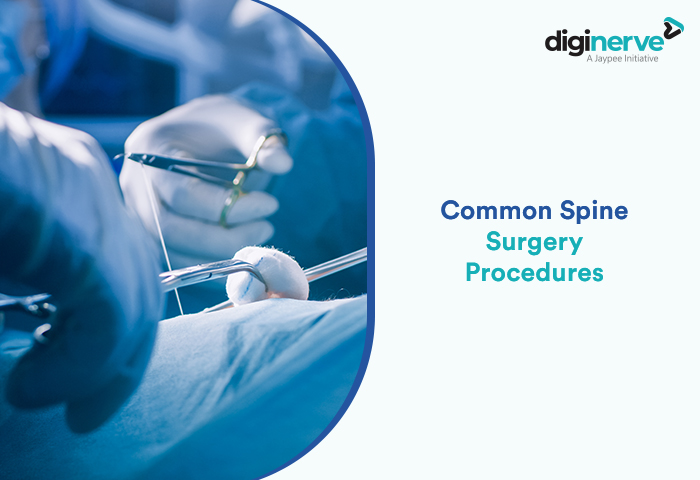The spine is a column of bones that runs from the head to the lower back. It is made up of 33 vertebrae stacked on top of each other. The spine has several important functions such as supporting the body's weight, protecting the spinal cord and nerves, and allowing for movement of the head, neck, and back.
Most Common Medical Issues Related to Spine
Some
of the most common medical issues related to the spine include:
· Herniated disc: A herniated disc occurs when the soft, gel-like center of an intervertebral disc (the cushion between the vertebrae) pushes out through a tear in the outer ring of the disc, i.e, the annulus is damaged and the soft inner material of nucleus pulposus gets ruptured and comes out of its normal space. This can put pressure on the spinal nerves. This extra pressure can cause pain, numbness, and weakness.
·
Spinal stenosis: Spinal stenosis is a narrowing of the spinal canal that
creates pressure on the spinal cord and nerves. This can cause pain, numbness,
and weakness in the arms, legs, and back.
·
Spondylolisthesis: Spondylolisthesis is a condition in
which one vertebra slips out of place over the vertebra below it. This causes
pain, nerve crowding, or tenderness.
·
Degenerative disc disease: Degenerative disc disease is a
condition in which the intervertebral discs break down over time. This can lead
to pain, stiffness, and reduced range of motion in the spine.
Medical Conditions That Might Require Spine Surgery
Spine surgery may be recommended for a variety of medical conditions, including:
·
Herniated disc
·
Spinal stenosis
·
Spondylolisthesis
·
Degenerative disc disease
·
Spinal tumors
·
Spinal fractures
·
Infections of the spine
Most Common Spine Surgery Procedures
The
most common spine surgery procedures include:
·
Microdiscectomy: A microdiscectomy is a minimally invasive procedure
to remove a herniated disc fragment that is putting pressure on a nerve root.
·
Lumbar fusion surgery: Lumbar fusion surgery is a
procedure to join two or more vertebrae together to create a stable unit. This
can be done to treat a variety of conditions, including degenerative disc
disease, spondylolisthesis, and spinal stenosis.
·
Cervical disc replacement: Cervical disc replacement is a
procedure to replace a damaged disc in the neck with an artificial disc. This
can help relieve pain and improve range of motion in the neck.
Types of Spine Surgery Procedures
There
are two main types of spine surgery procedures:
·
Open spine surgery: Open spine surgery involves a large
incision in the back to treat the spine. This type of surgery is typically used
for more complex procedures, such as spinal fusions and tumor removals.
·
Minimally invasive spine surgery (MISS): MISS involves smaller
incisions and the use of specialized instruments to treat the spine. This type
of surgery is less invasive and can offer a number of benefits, such as shorter
recovery times and less pain.
How to Choose the Best Online Resource for Learning About Spine Surgery?
When
choosing an online resource for learning about spine surgery, there are a few
factors to consider:
·
Content quality: Make sure that the course content is comprehensive
and up-to-date. Look for courses taught by experienced faculty that cover all
aspects of spine surgery, from basic concepts to advanced techniques.
·
Teaching methods: Choose a course that uses a variety of teaching
methods, such as lectures, videos, and interactive exercises. This will help
you learn the material more effectively.
·
Cost: Online courses on spine surgery can vary in price. Choose a
course that is affordable for you and that fits your budget.
DigiNerve’s Exclusive Course on Spine Surgery
While
there are many online courses on spine surgery, but DigiNerve offers a
comprehensive course called “Ganga Videos on Spine Surgery”. This course is led
by a team of renowned educators like Prof. Rajasekaran Shanmuganathan, Dr. Ajoy
Prasad Shetty, and Dr. Rishi Mukesh Kanna.
The
course includes video lectures, lecture notes, benchmark trials, and
self-assessment questions. It covers various aspects of spine surgery,
providing a thorough understanding of the subject.
Conclusion
Spine
surgery is a complex and challenging field, but it is also a rewarding one. If
you are interested in learning more about spine surgery, DigiNerve is a
reliable learning resource for you. With its comprehensive content, unique
features, and affordable pricing, DigiNerve is the perfect way to learn all you
need to know about spine surgery.

Comments
Post a Comment